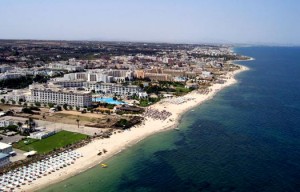- The predominant climate types are Mediterranean in the north and Saharan in the south. Four climatic sub-regions can be identified: sub-humid in the far north, semi-arid in the northwest and at Cap Bon, arid in the centre and hyper-arid and desert in most of the south. Over 40% of the country lies in the hyper-arid zone. Although average annual rainfall amounts to 220 mm, geographic variation is substantial, with regional averages ranging from 1,500 mm in the north to 50 mm in the far south, in the heart of the Sahara.
- The arid plains that mark the northern limit of the Sahara include many depressions, locally called chotts and sebkhats, which fill with water in winter and dry up in summer. Their water is highly saline. The largest chott, Jerid, is a 500 km2 salt lake.
- Tunisia has a dense hydrographic network in the north, whose river basins account for 81% of the national surface water potential. Oued Mejerda, which rises in Algeria, is the biggest river, with an annual water potential of around 0.8 billion m3. The south is characterized by large, deep aquifer networks whose low recharge rates make them barely renewable.
- Tunisia’s annual water potential is estimated at 4.8 billion m3, with groundwater amounting to about half (2.1 billion m3). In 2005, the exploitation rate was roughly 80% for deep aquifers and an unsustainable 108% for shallow aquifers.
- The high variation in rainfall, amount of arid land and overuse of groundwater resources make storage of freshwater a vital necessity in Tunisia. In 2005, there were 27 large dams, 200 small hillside dams and 660 hillside lakes, with a combined capacity of 1.8 billion m3 per year, amounting to 66% of the total surface water potential.
- In 2006, agriculture accounted for 81% of overall water consumption.
In urban areas, drinking water coverage had reached almost 100% by 1993. Tunisia achieved this by transferring large amounts of water from the humid north to the arid south, and by installing desalination facilities to treat brackish water in the tourist areas of the southeast. In rural areas, access to drinking water expanded from 62% in 1990 to 84%, on average, in 2006. Over the same period, coverage for the country as a whole advanced from 82% to 94%.
The section “Did You Know…?” is taken from the 3rd World Water Development Report “Water in a Changing World“.


